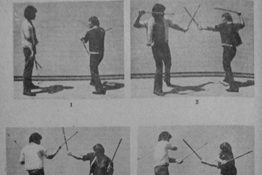A knowledgeable teacher of the Filipino martial arts (FMA) or any martial art knows the dividing line between practice and reality. But more importantly, he is quick to point out to his students the distinction between these two extremes.
The objective of any drill, whether with weapons or empty hands, should be clear to the student. Is the goal to learn practical self-defense skills or just to develop certain attributes?
If the goal is attributes development, it must be clear to the student which one he is working on whether it is speed, power, reflex, accuracy, coordination or whatever.
If the objective however, is to teach self-defense skill, it must be explained to the student the strength and limitation of the skill he is learning as well as the possible legal ramification of using it against an attacker.
In the case of knife fighting, I have a favorite quote from author Marc ‘Animal’ MacYoung that says, “The bottom line is that in the eyes of the law, using a knife on another human being is using ‘deadly force.’ There is a very narrow spectrum where the use of lethal force is allowed, and if you don’t know it you will end up in prison, losing everything you own to litigation – or both.”
Generally speaking, drills that involve gross motor skills (simple movements) are meant for practical self-defense training while drills that use fine motor skills (complex movements) are often suited for attributes development.
The preference for gross motor skills for self-defense training was based on the human body’s natural response to threat. When faced with danger, the human body tends to revert back to using gross motor skills not fine motor skills.
Functional self-defense skills should be low-maintenance, meaning you can expect them to work even if you’re not practicing them for a long time. It’s like learning how to swim or learning how to ride a bike – once you’ve learned them the kinaesthetic skills stay with you for life. You may not be doing them for a long time but once you hit the water you know you’re going to float and the moment you ride a bike and began to pedal, you know you can keep your balance.
It is my humble opinion that blade survival drills should be based on how the human body reacts naturally to threat rather than how a particular martial art wants it to react based on stylistic preference.
I believe that practitioners of FMA blade skills would benefit greatly from the research of renowned defensive tactics and close-quarter combat instructor Tony Blauer on the startle response or the so-called primal flinch. Blauer in many articles and seminars explained that whenever a human being sees threat coming his way, his reaction, 100 percent of the time, is to flinch–bringing his arms up in an attempt to push the danger away.
Blauer’s research was backed by forensic data. Knife attack victims for one, almost always sustain defense wounds on the arms because of the flinch reaction. In car accidents when the passenger was not wearing a seatbelt, traumas are located too, in the arms because of the startle response.
Blauer developed a wide spectrum of tactical skills based on the startle response and primal flinch that encompasses not only empty hand but also gun fighting skills. His research and training methods are now widely used by law enforcement and military organizations around the world.
Knives were usually used for ambushes in real-life situations hence it is self-explanatory how the element of the startle response would fit into FMA blade training.
Practicing hard contact sparring or experiencing a real fight could serve as filters to determine which stuff are good for actual combat and which ones are for gym practice only. And then there is the tricky question: “Is a martial arts teacher who has experienced an actual fight better than somebody who has not?”
Personally speaking, I have learned a great deal from both. In my years of studying the martial arts, I have met teachers who have used their art in real combat and survived. I valued their insights because their experiences offer clues on what techniques and psychological states would serve you well in a real fight.
On the other hand, I have also met teachers who’ve never been in a real fight but possess the uncanny ability of explaining the nuances of a martial art. In relation to the latter, I would like to cite an example from boxing. The late legendary trainer Angelo Dundee is not a fighter but his coaching skills propelled fighters like Muhammad Ali and Sugar Ray Leonard to heights of greatness.
But while the goal of the majority of FMA practitioners is to learn functional combat skills, remember that there are some who are just practicing for their sheer love of the artistry of the movements. These people are not training to become fighters but are seeing the martial arts as a vehicle for artistic expression – and to me, that’s all right too. To each his own, they say.





















